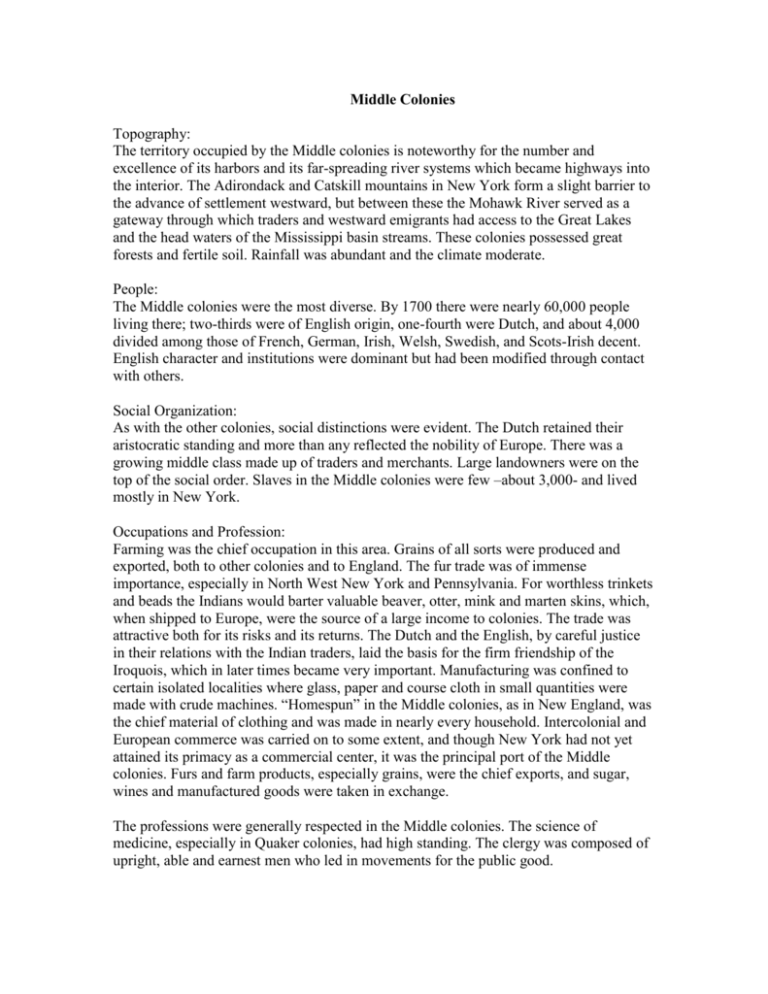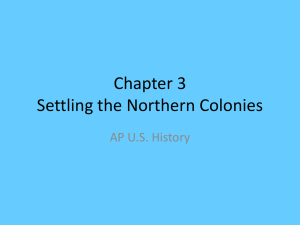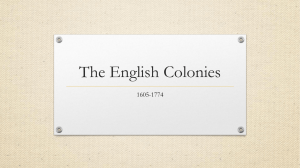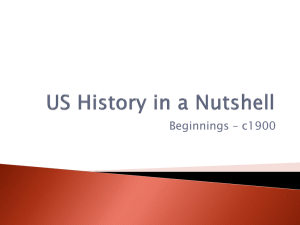Middle Colonies - Mesa Public Schools
advertisement

Middle Colonies Topography: The territory occupied by the Middle colonies is noteworthy for the number and excellence of its harbors and its far-spreading river systems which became highways into the interior. The Adirondack and Catskill mountains in New York form a slight barrier to the advance of settlement westward, but between these the Mohawk River served as a gateway through which traders and westward emigrants had access to the Great Lakes and the head waters of the Mississippi basin streams. These colonies possessed great forests and fertile soil. Rainfall was abundant and the climate moderate. People: The Middle colonies were the most diverse. By 1700 there were nearly 60,000 people living there; two-thirds were of English origin, one-fourth were Dutch, and about 4,000 divided among those of French, German, Irish, Welsh, Swedish, and Scots-Irish decent. English character and institutions were dominant but had been modified through contact with others. Social Organization: As with the other colonies, social distinctions were evident. The Dutch retained their aristocratic standing and more than any reflected the nobility of Europe. There was a growing middle class made up of traders and merchants. Large landowners were on the top of the social order. Slaves in the Middle colonies were few –about 3,000- and lived mostly in New York. Occupations and Profession: Farming was the chief occupation in this area. Grains of all sorts were produced and exported, both to other colonies and to England. The fur trade was of immense importance, especially in North West New York and Pennsylvania. For worthless trinkets and beads the Indians would barter valuable beaver, otter, mink and marten skins, which, when shipped to Europe, were the source of a large income to colonies. The trade was attractive both for its risks and its returns. The Dutch and the English, by careful justice in their relations with the Indian traders, laid the basis for the firm friendship of the Iroquois, which in later times became very important. Manufacturing was confined to certain isolated localities where glass, paper and course cloth in small quantities were made with crude machines. “Homespun” in the Middle colonies, as in New England, was the chief material of clothing and was made in nearly every household. Intercolonial and European commerce was carried on to some extent, and though New York had not yet attained its primacy as a commercial center, it was the principal port of the Middle colonies. Furs and farm products, especially grains, were the chief exports, and sugar, wines and manufactured goods were taken in exchange. The professions were generally respected in the Middle colonies. The science of medicine, especially in Quaker colonies, had high standing. The clergy was composed of upright, able and earnest men who led in movements for the public good. Life and Manners: The most interesting type of life in the Middle colonies was that of the Dutch, whose thrift, cleanliness and contentment have become proverbial. Their quaint houses contained few luxuries but were simple and cozy and adorned with dainty tile ornaments, antique pewter and odd utensils. But in character the people were “shrewd and greedy; they were enterprising but stubborn, and led a slow, monotonous narrow life.” Wealthy landowners often possessed homes in both the country and city. In the vicinity of Philadelphia and the coast, a sober, intellectual and moral tone prevailed from the dominance of Quakers. New York was a metropolitan region and possessed a social life of elegance and polish. Second to New York was Philadelphia, “the Quaker capital,” a beautiful city laid out with care and simple lines. Other towns of importance were Albany, the center of the fur trade; Germantown, a manufacturing center; Newcastle, Delaware and Trenton, New Jersey. Communication: Travel was encumbered by the lack of good roads. Taverns and inns were to be found in every village and became social centers and places to discuss politics as well as to gossip. Intellectual, Moral and Religious Conditions: Education was not generally encouraged in any of the Middle colonies –except perhaps among the Quakers. There were some sectarian schools and some private schools supported by small associations. Religious tolerance was the nominal rule in these colonies, though Roman Catholics were not allowed to hold office except in Pennsylvania. The Church of England was established everywhere except in Pennsylvania. In other communities, Congregationalism, Quakerism, the Dutch Reformed Church, Lutheranism, and Scottish Presbyterianism dominated. Political Organization: The Middle colonies were originally proprietary colonies, but all five of them were at some time royal provinces. Local government here, as elsewhere, was in the hands of the people, but the forms differed slightly from those in New England and the South. It was a county-town system. In New York, the township originally possessed nearly all powers of local government; in Pennsylvania, Penn had established a county system. Eventually in both colonies the county was governed by a board of supervisors consisting of one representative from each town, chosen by the freemen. Quakers: 1. Came to the New World from England in the 1600s seeking religious freedom. They are Christians who believe that something of God dwells within every person –it is called an inward light. They tend to think of Jesus Christ as a model, or a person with valuable lessons to teach. Their religious practice is unprogrammed. Quakers believe in total honesty in all areas of life. They do not take oaths or swear on the Bible. Most devote their lives to spiritual growth and service to mankind. 2. They believe in the equality of the sexes, pacifism, and a simple way of life. In the Quaker religion, all people are children of God and equal. 3. Important Quakers: Founder George Fox who at age twenty quit his job and wondered the countryside in search of himself. Said that God was not in the minds of ministers or in the halls of churches, but in the hearts of people. – Buddhism? Fox came to America in 1671. He returned to England two years later where he met Penn who was 29 years old. William Penn was imprisoned in the Tower of London for writing a book in which he criticized churches, ministers, modern life, and England. Penn came to America where in 1681, the king granted Penn a huge land track across the Delaware River. A Quaker colony was established –it would later be known as Pennsylvania. Lucretia Mott organized the Philadelphia Female Anti-Slavery Society. Angelina and Sarah Grimke organized an anti-slavery movement and supported women’s rights. Susan B. Anthony promoted the right to vote. Elizabeth Gurney Fry spearheaded prison reform. Florence Kelley founded the National Consumer’s League. Levi Coffin operated parts of the ‘Underground Railroad’. AFSC –American Friends Service Committee- operates today as a humanitarian organization. Nobel Peace Prize in 1947. Other Quakers: Mary Dyer; Dolly Madison; Herbert Hoover; Richard Nixon. 4. Quakers arrived in America in 1656. Maryland passed laws calling for them to be whipped and four Quakers were hung for continuing to preach what others considered heresy –a challenge to their religious beliefs. 5. Points of interest: Will not join the military. Dealt directly with Indians –buying their land at fair prices and did not bring whiskey to the negotiating table. Indians rarely killed unarmed Quakers. Did not support the Revolution. Took a stand against slavery, but never served in the Civil War. During WWI COs were assigned alternate service. Some 500 were sentenced to death, but never executed. During WWII COs were assigned unpaid alternative service. Quakers oppose the stockpiling of nuclear weapons. They joined protest movements against both the Korean and Vietnam Wars.








